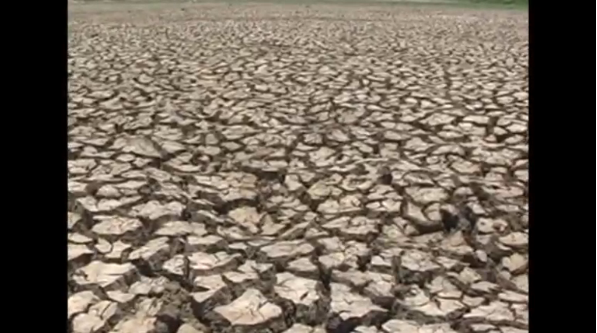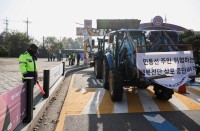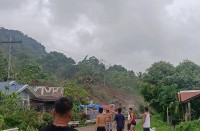
URANGABAD, MAHARASHTRA, India (Reuters) — Millions stand for hours in scorching summer heat to fetch water as back-to-back drought years cause unprecedented shortages in western Maharashtra, the country’s richest state.
Parts of India is facing its worst drought in four decades, ravaging crops, killing livestock, emptying reservoirs and water supplies used by industry and residents.
Now, hydroelectric and thermal power plants are starting to grind to a halt.
A picture of the state’s chief minister, from Prime Minister Narendra Modi’s ruling party, was draped over a 50-wagon train as it brought water to Latur, a town 500 km (300 miles) southeast of Mumbai city in the drought-stricken Marathwada region.
But although images of the water trains have led news bulletins, the amounts delivered are too small to meet the needs of the town’s half a million people and a parched region that is home to 19 million.
An unemployed labourer, Haribhau Kamble, said that he had to stand in line for three hours to fill two plastic pitchers from a government water tap.
“They say water has been brought by railway wagons and dispatched through tankers. All this they say to the media, but in this part of the city, one water tanker makes a trip only after eight days. It gives water to people having coupons for 200 litres, but other people don’t get it as they don’t have coupons. Only after eight days people get water by tankers” said Kamble, on Wednesday (April 20).
Marathwada, Telangana and Karnataka in the south, Madhya Pradesh in the centre, and Bundelkhand and Punjab in the north, have also been hard hit.
Nearly half the districts in the country received below-average rainfall in last year’s monsoon, the rainy season that runs from June to September. The federal government told the Supreme Court this week that 330 million people – a third of the national population – were affected by drought.
Water scarcity will worsen in the next two months as summer temperatures soar above 40 degrees Celsius (104°F), hastening evaporation in reservoirs that have all but run dry.
Modi’s government acknowledges that climate change and population growth are straining India’s scarce water resources and it is focusing on conservation, managing watersheds, linking rivers and boosting irrigation to manage drought.
Environment Minister Prakash Javadekar said that India has faced drought for the last 30 years and would address it through conservation, management of waterways, new irrigation schemes and more efficient water use.
India has 17 percent of the world’s population, but only four percent of fresh rain water resources are available.
Activists involved in water conservation say Maharashtra’s impending water crisis became clear when last year’s monsoon failed. The state took no early action to curb supplies to water-intensive industries like beer or sugar.
They say that, had the state government reserved sources for drinking water last year, the problem would not have been so big, as there was a limit to water supply through trains.
Local reservoirs now hold three percent of their capacity and the state is using 4,012 tankers to supply water to 7,862 villages and hamlets – three times the fleet deployed in 2015.
In most villages and towns, supplies of tap water were halted months ago and in some, nearly two years back.
The moment a water tanker arrived in the village of Masurdi in Latur district, 100 people surrounded it. Inside 15 minutes, they had siphoned out 12,000 litres through plastic hoses.
It was found that most water sources were dried up in Marathwada.
A resident of Latur, Fatima Mulani, pumped by hand for nearly an hour but failed to fill her 10 litre pitcher.
“Since 6′ o clock in the morning we are pumping and we managed fill only three pitchers. To fill a pitcher we need to pump for an hour. Tankers are not supplying water in our area. In the village well they discharge one tanker, but we never get water from that well. We don’t have any source for water. We have to buy water. We don’t have work, but we have to pay for water,” said Mulani.
Farmer suicides have nearly doubled this year in Marathwada,
Farmers like Vaijynath Gopalghare committed suicide as his sorghum and chickpea crops withered.
“We have four acres of land in our father’s name, but we couldn’t earn anything from the farm due to the drought. For the last three years we have had drought. For his elder daughter’s wedding, he sold one acre of land. He had 100,000 rupees ($1,509.50) outstanding loan from the Bank of Maharashtra and another 100,000 rupees loan from a co-operative society,” said his elder brother Vininath.
Farmers unable to harvest four consecutive crops are praying that forecasts of an abundant monsoon this year come true.
In this arid region, cultivation of thirsty sugarcane has expanded rapidly, and sugar mills suck dry reservoirs meant to supply drinking water.
The state government now proposes to restrict cane cultivation, but farmers are reluctant to grow other crops like cotton or soybeans that offer lower returns.
It also proposes a five-year ban on new sugar mills in Marathwada and may make water-conserving drip irrigation compulsory.







